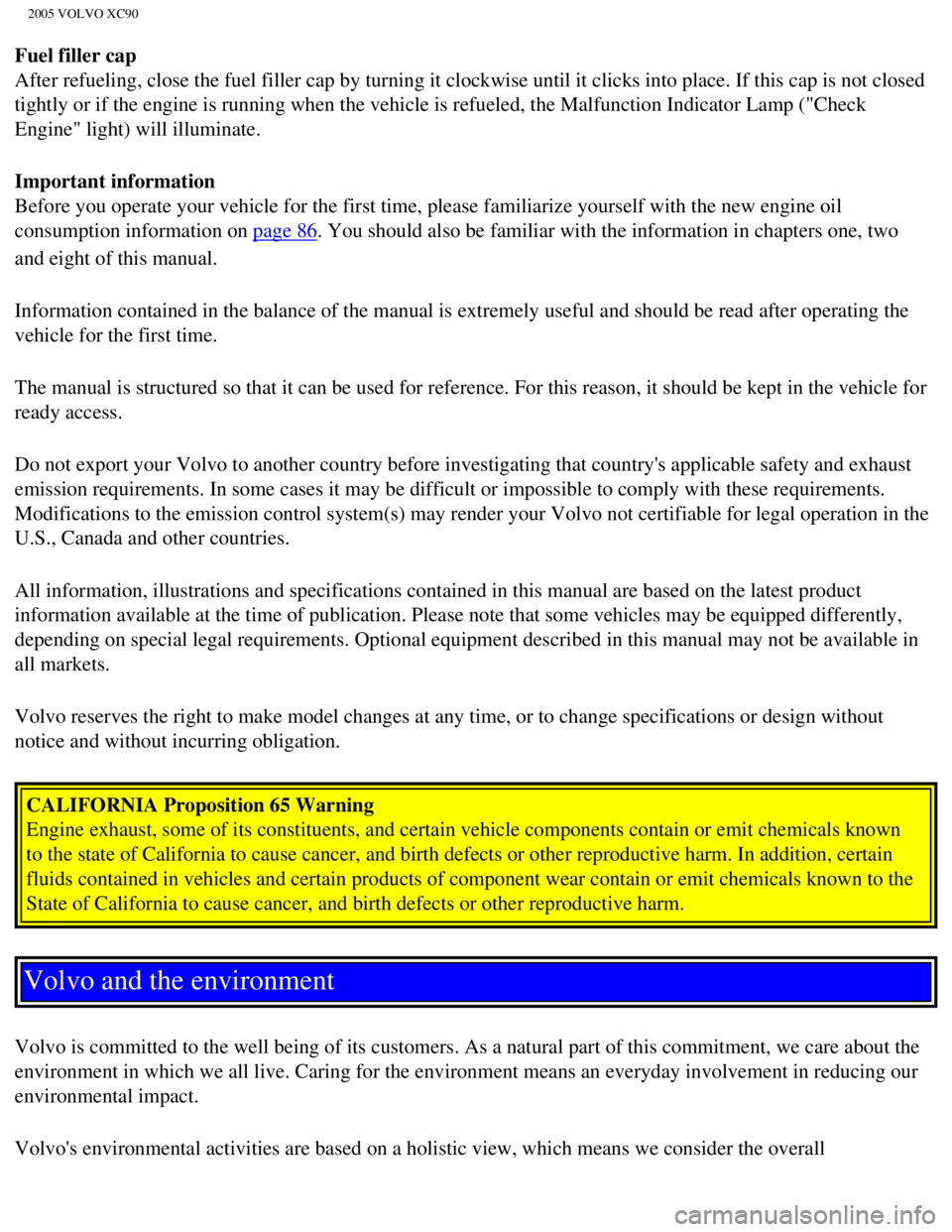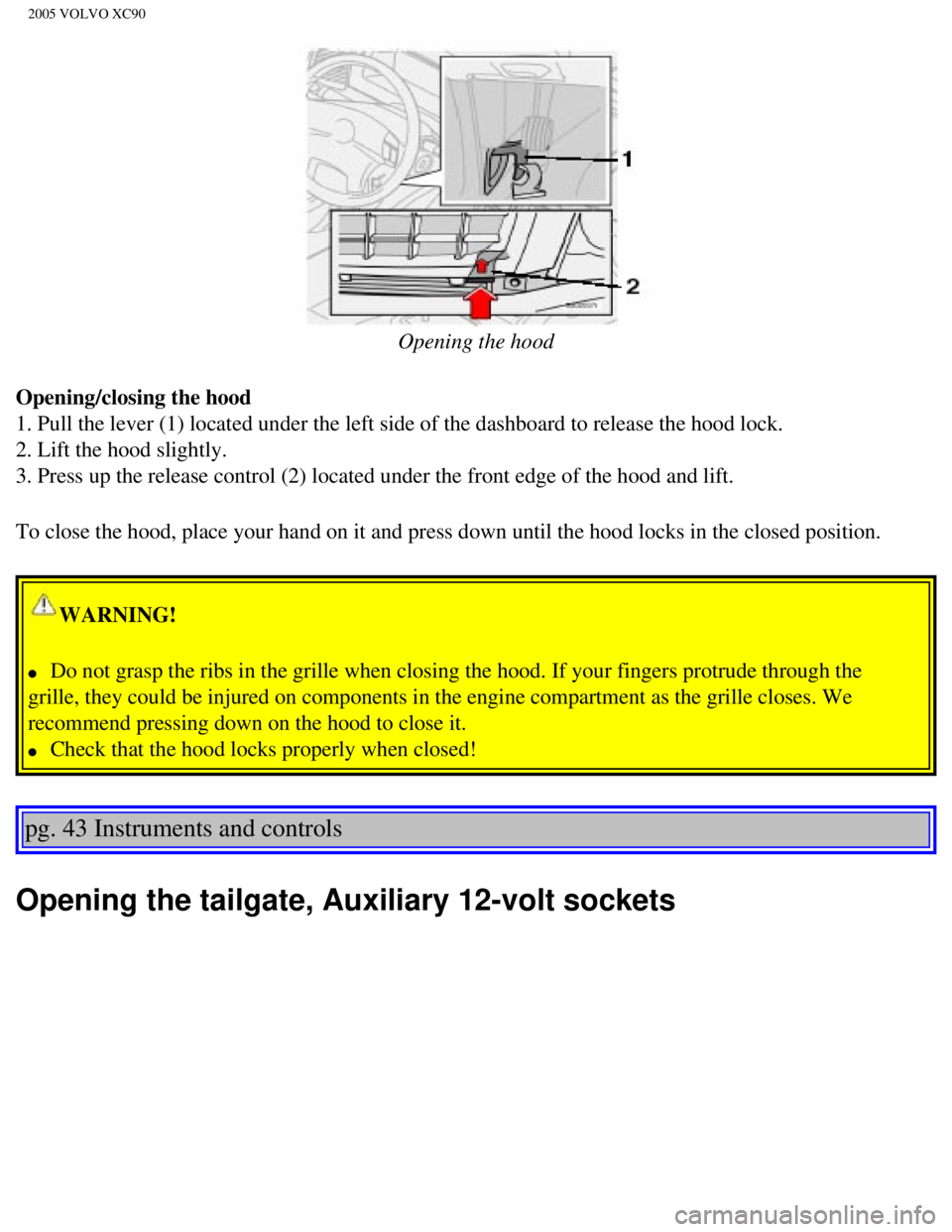check engine VOLVO XC90 2005 Owners Manual
[x] Cancel search | Manufacturer: VOLVO, Model Year: 2005, Model line: XC90, Model: VOLVO XC90 2005Pages: 263, PDF Size: 6.99 MB
Page 3 of 263

2005 VOLVO XC90
Fuel filler cap
After refueling, close the fuel filler cap by turning it clockwise until\
it clicks into place. If this cap is not closed
tightly or if the engine is running when the vehicle is refueled, the Ma\
lfunction Indicator Lamp ("Check
Engine" light) will illuminate.
Important information
Before you operate your vehicle for the first time, please familiarize y\
ourself with the new engine oil
consumption information on
page 86. You should also be familiar with the information in chapters one, two \
and eight of this manual.
Information contained in the balance of the manual is extremely useful a\
nd should be read after operating the
vehicle for the first time.
The manual is structured so that it can be used for reference. For this \
reason, it should be kept in the vehicle for
ready access.
Do not export your Volvo to another country before investigating that co\
untry's applicable safety and exhaust
emission requirements. In some cases it may be difficult or impossible t\
o comply with these requirements.
Modifications to the emission control system(s) may render your Volvo \
not certifiable for legal operation in the
U.S., Canada and other countries.
All information, illustrations and specifications contained in this manu\
al are based on the latest product
information available at the time of publication. Please note that some \
vehicles may be equipped differently,
depending on special legal requirements. Optional equipment described in\
this manual may not be available in
all markets.
Volvo reserves the right to make model changes at any time, or to change\
specifications or design without
notice and without incurring obligation.
CALIFORNIA Proposition 65 Warning
Engine exhaust, some of its constituents, and certain vehicle components\
contain or emit chemicals known
to the state of California to cause cancer, and birth defects or other r\
eproductive harm. In addition, certain
fluids contained in vehicles and certain products of component wear cont\
ain or emit chemicals known to the
State of California to cause cancer, and birth defects or other reproduc\
tive harm.
Volvo and the environment
Volvo is committed to the well being of its customers. As a natural part\
of this commitment, we care about the
environment in which we all live. Caring for the environment means an ev\
eryday involvement in reducing our
environmental impact.
Volvo's environmental activities are based on a holistic view, which mea\
ns we consider the overall
file:///K|/ownersdocs/2005/2005_XC90/05xc90_00.htm (3 of 7)12/30/2006 \
4:42:22 PM
Page 4 of 263

2005 VOLVO XC90
environmental impact of a product throughout its complete life cycle. In\
this context, design, production,
product use, and recycling are all important considerations.
In production, Volvo has partly or completely phased out several chemica\
ls including chlorofluorocarbons
(CFCs), lead chromates, naphtanates, asbestos, mercury and cadmium; an\
d reduced the amount of chemicals
used in our plants 50% since 1991.
Volvo was the first in the world to introduce into production a three-wa\
y catalytic converter with Lambda
Sond, now called oxygen sensor, in 1976. The current version of this hig\
hly efficient system reduces emissions
of harmful substances (CO, HC, NOx) from the exhaust pipe by approxima\
tely 95% and the search to eliminate
the remaining emissions continues. Volvo is the only automobile manufact\
urer to offer CFC-free retrofit kits
for the air conditioning system of all models as far back as the 1975 Vo\
lvo 240. Advanced electronic engine
controls, refined purification systems and cleaner fuels are bringing us\
closer to our goal.
After Volvo vehicles and parts have fulfilled their use, recycling is th\
e next critical step in completing the life
cycle. The metal content is about 75% of the total weight of a vehicle, \
which makes the vehicle among the most
recycled industrial products. In order to have efficient and well contro\
lled recycling, many Volvo variants have
printed dismantling manuals, indicating the weight and material of indiv\
idual components. For Volvo, all
homogeneous plastic parts weighing more than 1.7 oz. (50 grams) are ma\
rked with international symbols that
indicate how the component is to be sorted for recycling.
In addition to continuous environmental refinement of conventional gasol\
ine-powered internal combustion
engines, Volvo is actively looking at advanced technology alternative-fu\
el vehicles.
When you drive a Volvo, you become our partner in the work to lessen the\
vehicle's impact on the environment.
To reduce your vehicle's environmental impact, you can:
l Maintain proper air pressure in your tires. Tests have shown decreased f\
uel economy with improperly
inflated tires.
l Follow the recommended maintenance schedule in your Warranty and Service\
Records Information booklet.
l Drive at a constant speed.
l See an authorized Volvo retailer as soon as possible for inspection if t\
he check engine (malfunction
indicator) lamp illuminates, or stays on after the vehicle has started.\
l Properly dispose of any vehicle-related waste such as used motor oil, us\
ed batteries, brake pads, etc.
l When cleaning your vehicle, use Volvo's own vehicle care products, all o\
f which have systematically been
adapted to the environment.
For additional information regarding the environmental activities in whi\
ch Volvo Cars of North America, LLC
and Volvo Car Corporation are involved, visit our Internet home page at:\
http://www.volvocars.us
PremAir®
On the surface of the radiator in the engine compartment, there is a spe\
cial coating called PremAir®. PremAir®
file:///K|/ownersdocs/2005/2005_XC90/05xc90_00.htm (4 of 7)12/30/2006 \
4:42:22 PM
Page 15 of 263

2005 VOLVO XC90
WARNING!
Children must never be allowed in the front passenger's seat. Volvo reco\
mmends that ALL occupants
(adults and children) shorter than 4 feet 7 inches (140 cm) be seate\
d in the back seat of any vehicle
with a front passenger-side airbag. See
page 22 for guidelines.
Occupants in the front passenger's seat must never sit on the edge of th\
e seat, sit leaning toward the
instrument panel or otherwise sit out of position. The occupant's back m\
ust be as upright as comfort
allows and be against the seat back with the seat belt properly fastened\
.
Feet must be on the floor, e.g. not on the dash, seat or out of the wind\
ow.
No objects or accessory equipment, e.g. dashboard covers, may be placed \
on, attached to, or installed
near the SRS hatch (the area above the glove compartment) or the area \
affected by airbag deployment
(see illustration on
page 4).
There should be no loose articles, e.g. coffee cups, on the floor, seat \
or dashboard area.
Never try to open the SRS cover on the steering wheel or the passenger s\
ide dash. This should only be
done by an authorized Volvo service technician.
Failure to follow these instructions can result in injury to the vehicle\
occupants.
Safety system warning light in the instrument panel
A self-diagnostic system incorporated in the sensor monitors certain saf\
ety system components. A check
is performed on components such as seat belt locks, SRS, Occupant Weight\
Sensor, SIPS, and/or the
VIC system. If a fault is detected, the warning light will illuminate. T\
he light is included in the warning/
indicator light cluster in the instrument panel. Normally, the safety sy\
stem warning lamp should light up
when the ignition key is turned to positions I, II or III and should go \
out after approximately 7 seconds
or when the engine is started. Check that this light is functioning prop\
erly every time the vehicle is
started.
WARNING!
If the SRS warning light stays on after the engine has started or if it \
comes on while you are driving,
drive the vehicle to the nearest authorized Volvo retailer for inspectio\
n as soon as possible.
file:///K|/ownersdocs/2005/2005_XC90/05xc90_01a.htm (8 of 15)12/30/200\
6 4:42:24 PM
Page 40 of 263

2005 VOLVO XC90
pg. 26 Instruments and controls
Instrument panel
1. Turn signal indicators - right - left
2. Text window
The text window displays information and warning messages.
3. Temperature gauge
The pointer should be approximately midway on the gauge when driving. Do not drive the vehicle if
the warning light is on. The text window will provide you with additional information. If the en\
gine
temperature remains high, check coolant level - see
page 139.
4. Trip odometer
The trip odometers are used for measuring shorter distances. The right-h\
and digit gives tenth of a mile/
kilometer. Press the button for more than 2 seconds to reset. Change bet\
ween trip odometers 1 and 2
using one short press on the button.
5. Odometer
6. Speedometer
7. Warning symbol
8. High beam indicator
9. Tachometer
The tachometer shows engine speed in thousands of revolutions per minute\
(rpm). Do not drive
file:///K|/ownersdocs/2005/2005_XC90/05xc90_02a.htm (2 of 17)12/30/200\
6 4:42:27 PM
Page 41 of 263

2005 VOLVO XC90
continuously with the needle in the red area of the dial, which indicate\
s maximum allowable engine rpm
range. Instead, shift to a higher gear or slow the vehicle down. The eng\
ine management system will
automatically prevent excessively high engines speeds. This will be noti\
ceable as a pronounced
unevenness in engine speed.
10. Gear and driving mode indicator
The currently selected driving mode is displayed here. If you use the op\
tional Geartronic function on the
automatic transmission, the currently selected gear will be displayed.
11. Ambient temperature gauge
This display indicates the air temperature outside your vehicle. A "snow\
flake" symbol in the text
window is displayed when the temperature is in the range of 23 - 36° \
F (-5 - +2° C). Please note that this
symbol does not indicate a fault with your vehicle. At low speeds or whe\
n the vehicle is not moving, the
temperature readings may be slightly higher than the actual ambient temp\
erature.
12. Clock/set button
Turn the button to set the clock.
13. Fuel gauge
The fuel tank holds approximately:
Models with 6-cylinder turbo engines - 19 US gallons (72 liters).
Models with 5-cylinder turbo engines - 18 US gallons (68 liters).
When a warning light in the gauge comes on, there are approximately 1.8 \
US gal. (8 liters) of fuel
remaining in the tank.
14. Indicator and warning symbols
pg. 27 Instruments and controls
Indicator and warning symbols
The indicator and warning symbols light up when you turn the ignition ke\
y to the driving position
(position II) before starting. This shows that the symbols are functio\
ning. When the engine starts, all
symbols go out. If the engine is not started within 5 seconds, all symbo\
ls except CHECK ENGINE and
go out. The symbol for the parking brake goes out when the parking brak\
e is released.
Warning symbol
in center of instrument panel
This symbol shines as a red or yellow light depending on the severity of\
the fault that has been detected.
Red symbol -Stop the vehicle as soon as possible in a suitable location and read th\
e message shown in
file:///K|/ownersdocs/2005/2005_XC90/05xc90_02a.htm (3 of 17)12/30/200\
6 4:42:27 PM
Page 42 of 263

2005 VOLVO XC90
the text window.
Yellow symbol -Follow the instructions shown in the text window.
Anti-lock brake system ABS
If the warning light comes on, there is a malfunction of the ABS system \
(the standard braking system
will still function). The vehicle should be driven to a Volvo retailer \
for inspection. See
page 98 for
additional information.
pg. 28 Instruments and controls
Indicator and warning symbols (contd)
BRAKE Brake failure warning light
If the light comes on while driving or braking, stop immediately, open t\
he hood and check the brake
fluid level in the reservoir. See
page 140 for reservoir position and page 144 for instructions.
Canadian models are equipped with this warning light.
If the BRAKE and ABS warning lights come on at the same time, this could\
indicate a fault in the
brake system.
l Stop the vehicle in a suitable place and switch off the engine.
l Restart the engine.
l If both warning lights go off, no further action is required.
l If both lights are still on after the engine has been restarted, switch \
off the engine again and check the
brake fluid level (see
page 140 for the location of the brake fluid reservoir).
file:///K|/ownersdocs/2005/2005_XC90/05xc90_02a.htm (4 of 17)12/30/200\
6 4:42:27 PM
Page 43 of 263

2005 VOLVO XC90
WARNING!
The If the fluid level is below the MIN mark in the reservoir or if a "B\
rake failure - Service urgent"
message is displayed in the text window: DO NOT DRIVE. Have the vehicle \
towed to an authorized
Volvo retailer and have the brake system inspected.
l If the brake fluid level is above the MIN mark, drive carefully to an au\
thorized Volvo retailer and
have the brake system inspected.
DSTC
The Dynamic Stability and Traction Control system (DSTC) is explained \
in greater detail on
pages 99
and 100.
pg. 29 Instruments and controls
Supplemental Restraint system (SRS)
If the light comes on (or stays on after the vehicle has started), the\
SRS diagnostic system has detected a
fault. Drive to an authorized Volvo retailer for an inspection of the sy\
stem. See the SRS section for more
information.
Generator warning light
If the light comes on while the engine is running, have the charging sys\
tem checked.
Seat belt reminder
This symbol lights up to indicate that the driver has not fastened his/h\
er seat belt.
Tire pressure monitoring light
file:///K|/ownersdocs/2005/2005_XC90/05xc90_02a.htm (5 of 17)12/30/200\
6 4:42:27 PM
Page 44 of 263

2005 VOLVO XC90
See page 116 for more information on this function.
PARKING BRAKE
This light will be on when the parking brake is applied. The parking bra\
ke pedal is located on the left
side of the driver's footwell.
Canadian models are equipped with this symbol.
Rear fog light
This light indicates that the fog light is on.
Turn signal indicator - trailer (certain models)
If you are towing a trailer, this light will flash simultaneously with t\
he turn signals on the trailer. If the
light does not flash when signaling, neither the trailer's turn signals \
nor the vehicle's turn signals are
functioning.
Oil pressure warning light
If the light comes on while driving, stop the vehicle and then stop the \
engine immediately and
check the engine oil level See
page 142. If the light stays on after restart, have the vehicle towed to the
nearest authorized Volvo retailer. After hard driving, the light may com\
e on occasionally when the
engine is idling. This is normal, provided it goes off when the engine s\
peed is increased.
CHECK ENGINE Malfunction indicator light
On-Board Diagnostics II (OBDII): As you drive, a computer called "OBDI\
I" monitors your vehicle's
engine, transmission, electrical and emission systems. The CHECK ENGINE \
light will light up if the
computer senses a condition that potentially may need correcting. When t\
his happens, please have your
vehicle checked by a Volvo retailer as soon as possible.
A CHECK ENGINE light may have many causes. Sometimes, you may not notice\
a change in your
vehicle's behavior. Even so, an uncorrected condition could hurt fuel ec\
onomy, emission cleanliness, and
driveability. Extended driving without correcting the cause could even d\
amage other components in
your vehicle.
Canadian models are equipped with this warning light.
pg. 30 Instruments and controls
file:///K|/ownersdocs/2005/2005_XC90/05xc90_02a.htm (6 of 17)12/30/200\
6 4:42:27 PM
Page 46 of 263

2005 VOLVO XC90
FIX NEXT SERVICE: Have the system affected inspected at the next scheduled
maintenance.
TIME FOR REGULAR SERVICE This light will come on at 7,500 mile (12,000 km) intervals,
after 750 hours of driving or after 12 months, whichever occurs
first, to remind the driver that the maintenance interval has been
exceeded. The light will stay on for 2 minutes after start until
reset by the servicing retailer.
OIL LEVEL LOW - FILL OIL
a Check the oil level and top up if necessary. See page 142.
OIL LEVEL LOW - STOP
SAFELY
b Stop as soon as possible and switch off the engine, check the oil
level and top up if necessary. See page 142.
OIL LEVEL LOW - STOP
ENGINE
b Stop as soon as possible and switch off the engine, check the oil
level and top up if necessary. See page 142.
OIL LEVEL LOW - SEE
MANUAL
b Stop as soon as possible and switch off the engine, check the oil
level and top up if necessary.See page 142.
a. The yellow warning symbol also lights up (see
page 27)
b. The red warning symbol also lights up (see
page 27)
pg. 31 Instruments and controls
Switches in center console
Dynamic Stability Traction Control system (DSTC)
This button is used to switch off DSTC's stability Control function. See\
pages 99 and 100 for additional
file:///K|/ownersdocs/2005/2005_XC90/05xc90_02a.htm (8 of 17)12/30/200\
6 4:42:27 PM
Page 63 of 263

2005 VOLVO XC90
Opening the hood
Opening/closing the hood
1. Pull the lever (1) located under the left side of the dashboard to \
release the hood lock.
2. Lift the hood slightly.
3. Press up the release control (2) located under the front edge of th\
e hood and lift.
To close the hood, place your hand on it and press down until the hood l\
ocks in the closed position.
WARNING!
l Do not grasp the ribs in the grille when closing the hood. If your finge\
rs protrude through the
grille, they could be injured on components in the engine compartment as\
the grille closes. We
recommend pressing down on the hood to close it.
l Check that the hood locks properly when closed!
pg. 43 Instruments and controls
Opening the tailgate, Auxiliary 12-volt sockets
file:///K|/ownersdocs/2005/2005_XC90/05xc90_02b.htm (8 of 17)12/30/200\
6 4:42:28 PM